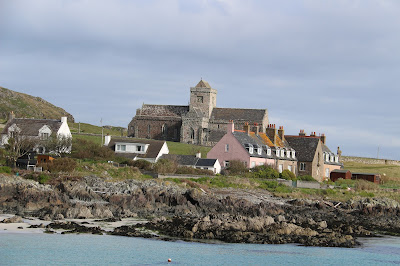This is the last post on our recent break on Mull and I thought I'd show a few photographs taken when we were on Iona. From what I gather, we had chosen a good time to be on the island as it gets extremely busy during the high season. Personally I think I would have been very disappointed if I'd gone there and found myself just one of many. The place has a unique tranquility and is best visited when there are few other distractions, like people.
 |
| Around the outer cloister wall is an array of medieval grave slabs. Many of these originally stood outside in St Oran's Chapel burial ground. The carving is intricate, with common motifs including flowers, swords, and hunting scenes. Many of the slabs commemorate clan chiefs, including MacKinnon, MacLean and MacLeod chieftains. |
 |
| Taking a break at the north end of Iona, looking out towards Staffa and Lungha. There are no footpaths on the island but, with the Right to Roam Act, most places are accessible. |
 |
| Another view of the interior of the Abbey, this time looking east-west towards the font and the main door. The choir stalls are in the forefront and were magnificently carved. |
 |
| One last look southwards down the Iona Sound.... |
 |
| ....before getting on the ferry back to Fionphort. We'll return to Iona one day. |








No comments:
Post a Comment